Ch3 Lexical Analysis
编译原理的第三章笔记, 讲述了词法分析器的内容.
The Role of the Lexical Analyzer
词法分析器将字节流转换为tokens, 同时将一些变量信息保存在Symbol Table中.
- Scanning
- Lexical analysis
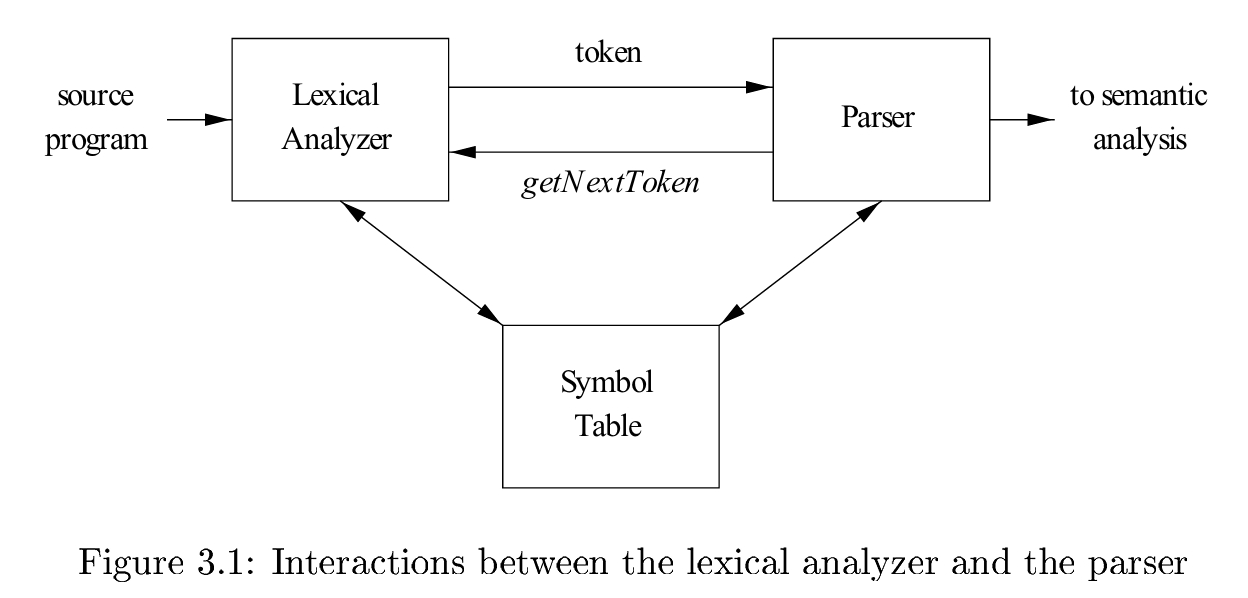
Lexical Analysis Versus Parsing
为何要将词法分析与解析(语法分析)显式地区分为两个环节?
- Simplicity: 细分使得两个环节的设计都变得更简单.
- Compiler effciency: 在lexical的环节, 可以用一些特别的技术, 来提高效率, 如buffer相关的技术.
- Compiler portability: 提高可移植性. Lexical analyzer可以是设备相关的.
Tokens, Patterns, and Lexemes
- A token is a pair consisting of a token name and an optional attribute value.
- A pattern is a description of the form that the lexemes of a token may take.
- A lexeme is a sequence of characters in the source program that matches the pattern for a token and is identified by the lexical analyzer as an instance of that token
Token类似类名, 它所包含的特性为pattern, 它的实例为许许多多的lexemes.
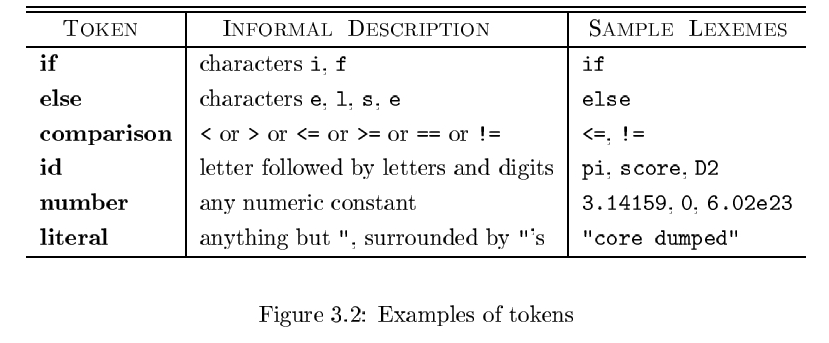
大部分语言中, token分为如下几类
- 关键字token:
if, else, then等 - 操作符token:
comparison等, 实例为>, < =等 - identifiers token:
id, 实例为各种变量名, 函数名 - constant number token:
number, 实例为0, 0.1, 3.14等 - 文本信息:
literal等, 实例为// some word, "some string"等 - punctuation symbol tokens: 各种标点符号token.
Attributes for Tokens
对于每一个token, 它们的lexeme都可以有很多个. 为了区分它们, 我们将其与一些info组合在一起, 这些info可能是包含许多信息的结构.
对于某些只可能含单个lexeme的token, 它们的info就不需要保存.
各个token的info各不相同, 例如id的info就是一个指向Symbol Table的指针, 而number则指向常量所在的地址.
Lexical Errors
一般无法在lexical的环节出现error. 如果出现了, 常见的处理方法是对剩余的input作delete / insert / replace / transpose操作, 直到遇到新的token.
Input Buffering
在扫描输入的时候, 我们总是需要读到下一个token的一部分内容, 才能确定当前的token已经结束. 因此, 我们采用two-buffer scheme 以及
"sentinels"的impove, 来更好地处理这种情况.
Buffer Pairs
- 两个buffer: 为了应对某个lexeme刚好处在buffer分界线的情况. (我们不考虑某个lexeme占据了整个buffer的情况)
- 两个指针: forward指针, 指向当前的index; lexemeBegin指针, 指向当前正在判断的lexeme的起始位置.
Sentinels
为了一致性, 我们将判断当前buffer是否结束的工作和判断当前读入的char的工作合并起来, 即添加特殊字符eof作为buffer结束的标志.
Specification of Tokens
Strings and Languages
与Automata中的内容相同, 此次只是简单罗列出定义.
- An alphabet is any finite set of symbols
- A string over an alphabet is a finite sequence of symbols drawn from that alphabet.
- A language is any countable set of strings over some fixed alphabet.
substring and subsequence
- substring: 字符串s删除任意前缀 / 后缀所得到的串
- subsequence: 字符串删除0个或多个不一定连续的位所得到的串
Operations on Languages
Languages上的一些操作. 由于languages是字符串的集合, 所以这些都是特殊的集合操作.
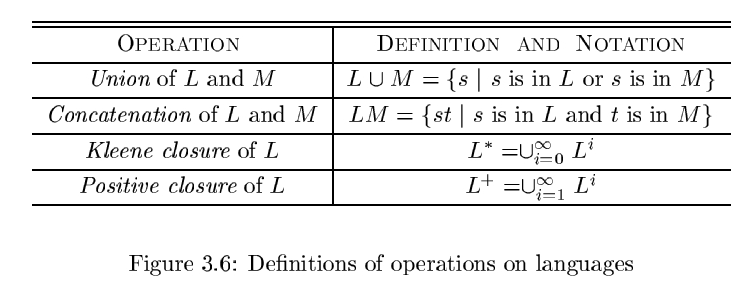
Regular Expressions
有了如上的集合操作作基础, 我们很容易就能得到正则表达式的形式化描述:
以某些字母表作为基础, 反复进行union, concatenation和Kleene closure操作而得到的新语言.
递归定义如下:
BASIS:
- 是正则表达式, 同时是只含空串的空语言
- 如果是字母表中的符号, 那么是正则表达式, 且.
INDUCTION:
如果是正则表达式, 且对应的语言为, 那么
- 是对应于语言的正则表达式
- 是对应于语言的正则表达式
- 是对应于语言的正则表达式
- 是对应于语言的正则表达式, 表明单纯添加括号不改变正则表达式所表示的语言
通过确定符号的优先级(如闭包操作优先级最高, 连接操作次之, 并操作优先级最低), 我们可以获得不含括号的正则表达式.
regular set: 能够被regular expression表示的语言.
若两个regular expression的regular set相等, 则称regular expression相等.
由此可以获得一些基本的代数性质:
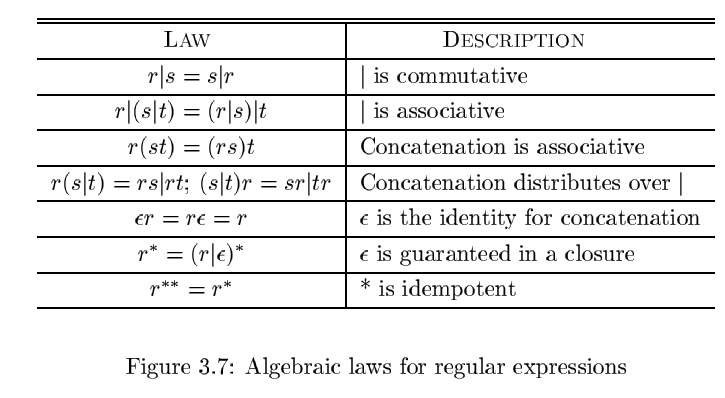
Regular Definitions
通过右箭头的方式, 来给某个正则表达式命名, 并通过已经命名的正则表达式不断向上构建, 最终得到包含复杂结构的式子.
Extensions of Regular Expressions
- One or more instances.
- Zero or one instance.
- Character classes. -
Recognition of Tokens
定义了一个例子语言, 包括其pattern和tokens.
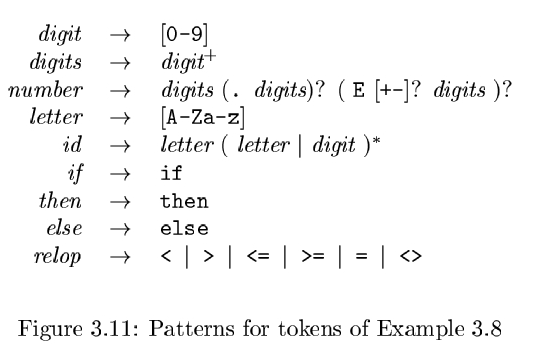
Transition Diagrams
一个DFA. 描述了例子语言的辨别token过程.
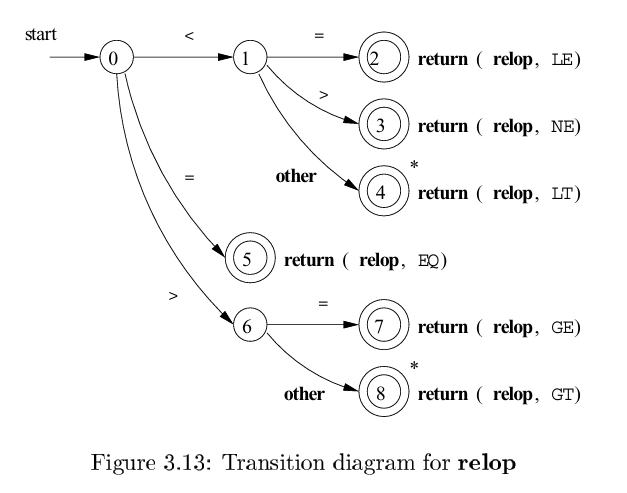
Recognition of Reserved Words and Identifiers
有两种方案:
- 预先将保留字保存到变量表中. 于是, 那些新加入的token就不可能是保留字, 只可能是
id - 单独为保留字建立transition diagrams
Completion of the Running Example
建立了unsigned numbers和whitespace的transition diagram
Architecture of a Transition-Diagram-Based Lexical Analyzer
- 对于单个transition diagram, 我们可以通过仔细的编排, 将其包装为一个函数.
- 为了用上每个transition diagram, 有如下的几种方案:
- 线性地, 一个接一个地尝试每个token, 在fail了之后将指针指向string头部, 并尝试下一个
- 并行化的, 将每个读入的字符同时输入给所有函数. 此时我们需要处理那些类似"thennextvalue"的问题, 即某些较短的token可能提前结束.
- 将所有transition diagrams合并为一个. 即将它们合并为一个巨大的DFA.
The Lexical-Analyzer Generator Lex
Use of Lex
Structure of Lex Programs
Conflict Resolution in Lex
The Lookahead Operator
Finite Automata
有穷自动机类似transition diagrams, 但是有一些不同
- Finite Automata对于每个输入string, 只返回"yes" or “no”
- Finite Automata有两类, NFA和DFA.
如下是关于NFA和DFA的一些形式化定义, 在Automata中已经给出, 此处不再赘述. 详见
[Compilers] Ch1 导论: Introduction | RIKKA’s Blog (rikka421.github.io)
Nondeterministic Finite Automata
Transition Tables
Acceptance of Input Strings by Automata
Deterministic Finite Automata
From Regular Expressions to Automata
Conversion of an NFA to a DFA
Simulation of an NFA
Effciency of NFA Simulation
Construction of an NFA from a Regular Expression
给出一个将正则表达式转换为NFA的算法.
The McNaughton-Yamada-Thompson algorithm to convert a regular expression to an NFA.
这个算法根据正则表达式的归纳定义, 同样的归纳进行构造, 很容易理解.
BASIS: 对于正则不等式和, 分别构造仅含两个状态的NFA.
INDUCTION: 对于并集, 拼接, 闭包操作, 分别构造特定结构的NFA.
